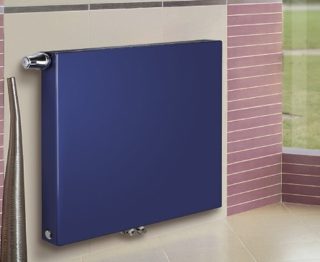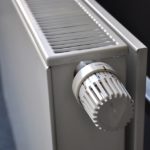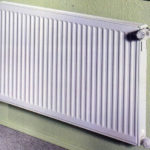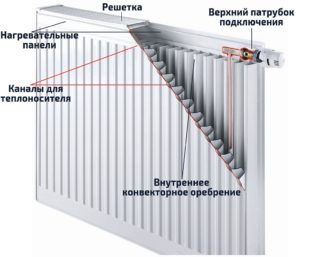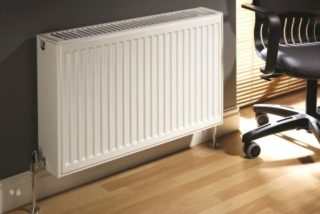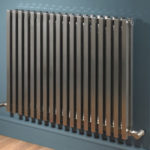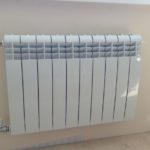Old-style flat heating radiators are in demand among buyers, due to the ratio of quality - price - technical characteristics, time-tested. The depth of the structure is taken as a key parameter, but its exact boundaries do not exist. The basis is taken products whose depth is 2 times less than the Soviet cast-iron models.
Characterization of flat radiators and their device
Steel products are classified as thin heating radiators. For their manufacture, metal sheets are taken passing through the stamping. By welding, iron billets are connected in an appropriate design, which ensures reliability and strength of the connection. To connect to a common system using nozzles. The movement of the coolant occurs through a special channel located between the two plates.
Construction happens:
- single and multi-row;
- with a smooth surface;
- with a profiled surface on one or two sides;
- flat;
- with or without ribs;
- with a thermostat.
A small depth is characteristic for each stamped sheet, which is associated with other design features:
- Two panels, welded together, have high heat dissipation.
- A small internal cavity for movement of the coolant. This is not only a plus, but also a minus. On the one hand, savings on the coolant saves the budget, on the other hand, it is necessary to constantly monitor the level of the supplied temperature.
The problem with fuel consumption is solved by adding convection ribs, as a result of which the design becomes known as ribbed.
- With thermostat
- Ribbed
Dimensions
For the correct separation of products into types, a special classification has been developed, by size.
- Type 10. This group includes products with a depth of 46 mm.
- Type 11. The thickness of these products is slightly increased, corresponding to 59 mm. This is due to the addition of convection ribs on one side of the battery.
- Type 12. The thickness of such radiators is 64 mm, due to the location of convection fins between two panels.
- Type 22. A product from two panels equipped with a fin. The depth of the product reaches 102 mm.
- Type 33. The widest radiators, their thickness is 157 mm due to the location of three plates with three parts of the fins.
Power depends on the type of product, height and length.
The smallest heat transfer is characteristic for products of type 10 and 11 with a height of 300 mm and a length of 400 mm. It is 265 watts. If we compare the radiator with the same parameters of class 21, the heat transfer will be equal to 370 watts.
Basically, flat radiators are available with heights from 300 mm to 600 mm and radiators from 400 mm to 3000 mm long.
Advantages and disadvantages

Thin batteries for heating owe their popularity and demand to such characteristics:
- aesthetic appearance;
- compactness;
- simplicity in leaving and service;
- low ability to accumulate dust;
- simple installation;
- light weight;
- no additional purchase of parts is required, the original equipment is complete;
- high heat dissipation;
- energy saving.
Such products and disadvantages are not without:
- susceptibility to corrosion;
- vulnerability to water hammer;
- fragility and vulnerability of damage during transportation.
Increase battery resistance to water hammer by installing a pressure reducer.
Features of flat type radiators
Among the characteristic qualities of flat batteries are:
- use of stamped steel sheet;
- the use of a steel sheet with a certain level of recess for the base;
- the relationship of heat transfer and battery area;
- the possibility of increasing heat transfer due to the continuous design;
- heat carrier and energy saving.
If there is a need to increase heat transfer, radiators are equipped with additional convection fins welded along the entire plane of the battery.
Varieties of flat radiators
According to the material of manufacture, thin batteries are:
- bimetallic;
- aluminum;
- steel;
- cast iron.
- Cast iron
- Bimetallic
By structure, heating radiators are conventionally divided into:
- single panel;
- two-panel;
- three-panel;
- three-ribbed.
Heat transfer depends on the area of the radiator. The larger the surface of the battery, the warmer it will be in the room.
For classification, the standard marking is used, which is applied to the packaging: Type 10, Type 11, Type 12, Type 22, Type 33. For the last two types, the term “flat” is not applicable. All modifications of these radiators, with the exception of products of type 10, are equipped with a grill and side decorative panels. This increases the cost of products.
Installation process
Flat modifications are installed only in closed heating systems, where the movement of the coolant is regulated by special pumps, and in the system itself there is an expansion tank.
Fluid motion technology:
- Through the pump, thermal energy moves along the pipeline.
- Passes through the valve.
- It reaches the end user.
- It moves through the air vent.
- Then towards the return pipe, until it reaches the expansion tank with the membrane.
- Next, the movement process is repeated.
When such samples are connected to an open heating system, their service life is significantly reduced. This is explained by the corrosion processes that act on the radiators when oxygen enters the battery, which is formed due to the frequent discharge of liquid in the system.
In rooms with a high level of humidity, the installation of flat radiators is not recommended.
Rules for the use of radiators
The length of service life depends on several factors:
- The presence of a pump for circulating fluid and an expansion tank. This will provide better fluid flow throughout the system.
- The frequency of the coolant drain. Do not do this often, as the likelihood of oxygen entering the radiator increases, which will lead to corrosion.
- Use of ordinary heat transfer medium. Antifreeze fluids are not recommended for steel products. Due to their use, heat transfer decreases.
- Compliance with temperature values. For flat radiators, there is a limitation in the temperature regime. Do not exceed the permissible value of 1000C.
- Compliance with working pressure. The recommended value is 4.5-10 MPa.
- The acidity of the water. Recommended acidity should be 8.5 PH.
By following the above recommendations, you can significantly extend the operational life of products.
The choice of flat radiators
Before purchasing radiators, it is necessary to familiarize yourself with the technical data of the products, make accurate calculations based on the parameters of the building or premises.
A few recommendations to help you choose the right equipment for your home:
- In heating systems with natural coolant circulation, flat radiators are not used.A forced system is required to ensure sufficient heat transfer.
- The maximum temperature maintained by flat products should not exceed 100 degrees.
- Connection is possible both on the left and on the right side. Right-side connection is used when installing single-panel models. Two-panel models have a universal type of connection.
- Radiators with a lower type of connection are much more expensive than products with a higher type.
- Radiators in classic white color belong to the cheap segment, other options are more expensive.
- To select a radiator model, you need to know the thermal power of the product and its height. The lower the radiator, the more evenly the heat enters the room and the denser the heat shield. Calculation of power is the task of the designer, who, in addition, must take into account heat loss through the enclosing structures.
- The width of the battery is calculated based on the size of the window unit. Ideally, installed radiators should cover the window by 50-75%. Narrow products will not be able to provide a sufficient thermal curtain.
When choosing equipment, it is advisable to give preference to time-tested brands. This includes Kermi, Zehnder and Buderus. The most affordable are Buderus products, the most expensive radiators are owned by Zehnder.
